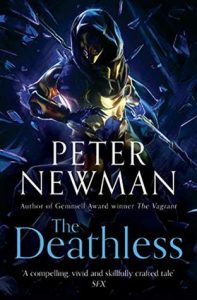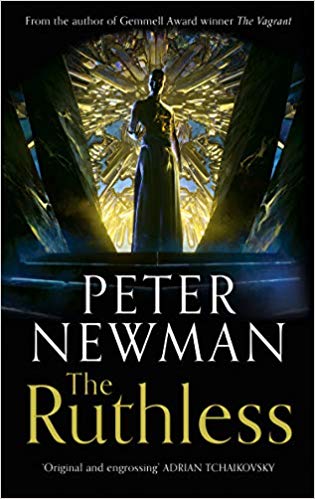THE RUTHLESS by Peter Newman (Book Review)
 The reader is reborn into Newman’s world of the Deathless, much as his protagonist Lady Pari is reborn into the body of her great-granddaughter Priti. Newman’s world offers neither character nor reader much time to catch their breath. Some sixteen years after the events of The Deathless and Lady Pari can only hope that the fragile and hastily formed alliances from the end of her last lifecycle have endured during her soul’s enforced absence from the mortal realm.
The reader is reborn into Newman’s world of the Deathless, much as his protagonist Lady Pari is reborn into the body of her great-granddaughter Priti. Newman’s world offers neither character nor reader much time to catch their breath. Some sixteen years after the events of The Deathless and Lady Pari can only hope that the fragile and hastily formed alliances from the end of her last lifecycle have endured during her soul’s enforced absence from the mortal realm.
While I will try to avoid spoilers for The Ruthless, it is inevitable that there will be some spoilers for The Deathless. It is, after all, impossible to say much about the direction the sequel takes without revealing some of the first book’s endpoints. So, you can see my review of The Deathless here and may wish to buy and read that book before going on to the rest of this review. 🙂
Newman shows us more of his world through the eyes of five point-of-view characters. Besides the masterful and scheming Lady Pari, we follow:
- Satyendra – the imposter, the changeling, the thing of the wild swapped at birth into a life as a tower-born honoured vessel for the reincarnation of Sapphire Lord Rochant, yet who cannot abide to be near the very crystals that his body must wear as armour when Rochant is restored into Satyendra’s body.
- Sa-at – the true tower-born babe, adopted and raised by Crowflies, the demon of the wild – unaware of his origins, just that he is different.
- Chamdi – honoured mother to the real Satyendra/Sa-at but oblivious (or wilfully blind) to the fact she has been raising the most unkindly of cuckoos in her lofty crystal nest. While hungry for her long period of duty as Rochant’s Seneschal to end through his return and reincarnation, she is also fearful of what that might mean for her son and her own humble ambitions, which centre on a coarse-tongued bearded roadborn traveller named Varg and his five-legged beast of burden Glider.
- And finally there is Vasin – Sapphire Lord, one of six deathless in the Sapphire house. It should have been seven, save only that Sapphire High Lord Yadavendra deliberately shattered one of the sacred godpieces that alone allow a soul to be reincarnated by the bringers of eternal order. Vasin must steer a fine line between addressing the festering sickness within his own house and providing essential support to the beleaguered minor house Ruby, set upon by attacks from the Wild of unparalleled viciousness and precision.
The distinctive voices, experiences and motivations of these five points of view enable Newman to lead the reader through a complex but fascinating tapestry of interwoven threads. The writing as ever is light and engaging with many lines that had me doffing my cap in the author’s direction. For example,
Yadavendra’s mouth worked silently for a moment, making ghosts of words that he could not bring himself to say.
But the people of Newman’s world face a multiplicity of threats. Humans, confined to life on thin bands of safety either side of the demon-searing godroads – like those isolated pockets of humanity left over in every zombie apocalypse movie – are a people under siege from the vastness of the Wild. While the majestic hunting powers of the deathless lords and ladies in their winged crystal suits of armour have preserved a precarious balance of power, the Wild is evolving. The original definitive zombies of “Dawn of the Dead” were slow and mindless, made fearsome only because of their sheer weight of numbers. But through several cinematic iterations – including 28 Days Later (not strictly a zombie movie) and Land of the Dead – zombies became faster and cleverer. So too Newman’s demons – infinitely more varied than any zombies – are changing, and Vasin is the first to spot the danger this new Wild poses.
 Sa-at lives in the Wild and, like that original lost boy, Mowgli of The Jungle Book, he has made his own accommodations with it. He knows its perils and understands its rituals – particularly the business of debts and payment. In the Wild nothing is without a price, even if the commodities traded would not feature on any currency or stock exchange. Sa-at has fashioned many bizarre friendships and numerous “deals,” every single one of which breaks the fundamental law of his human kindred: “No deal with the Wild.” This is quickly shown to be such an impractical position born of blind zealotry that you would almost think the humans deserved to die out (or is that another “No Deal” that I’m thinking of?). For all the comfort that he has, Sa-at knows he is not of the wild. Like Mowgli he lurks on the fringes of civilisation, watchful, eager for a different sense of belonging, but life is never easy for one who tries to straddle the two worlds – as others have found before him.
Sa-at lives in the Wild and, like that original lost boy, Mowgli of The Jungle Book, he has made his own accommodations with it. He knows its perils and understands its rituals – particularly the business of debts and payment. In the Wild nothing is without a price, even if the commodities traded would not feature on any currency or stock exchange. Sa-at has fashioned many bizarre friendships and numerous “deals,” every single one of which breaks the fundamental law of his human kindred: “No deal with the Wild.” This is quickly shown to be such an impractical position born of blind zealotry that you would almost think the humans deserved to die out (or is that another “No Deal” that I’m thinking of?). For all the comfort that he has, Sa-at knows he is not of the wild. Like Mowgli he lurks on the fringes of civilisation, watchful, eager for a different sense of belonging, but life is never easy for one who tries to straddle the two worlds – as others have found before him.
Tanzanite Lady Pari, used to being the queen on the chess board, or at least the kingmaker, finds herself and her brother cast as the expendable pawns, potential collateral damage in the necessity of provoking a reaction from the decay at the heart of House Sapphire. Fresh into her new body, aware that her brother is broken, his soul not entirely whole, she faces a multiplicity of challenges: to survive; to save him; to further the alliances she laid at the end of her last life cycle; to discover if old oaths have endured the enforced sixteen-year absence of her soul from the world.
But within Pari’s story we see the callous heart of the world Newman has created. When Varg first meets the reincarnated Pari he is confused, seeing her in the body of her great-grand-daughter Priti, a girl he has been training in secret ways to make her a suitable vessel for Pari’s rebellious soul. His simple reaction rings so true: “I didn’t think… that it would be this hard.” Much as Pari is a sympathetic character, there is that horror of realising she walks in another’s body – another who has gone – the body they prepared for youthful life gifted to another.
As a reader you rail against that fundamental injustice of stolen years of life, of another’s body ruthlessly appropriated. It reminded me in different ways of the film “Freejacker” where Mick Jagger is an agent scavenging a body from the past for a rich but fatally diseased billionaire to transplant himself into, or of the film “Out of Time,” or the SPFBO#4 finalist The Anointed where years of life can be traded or stolen in a truly sick economy. Or even Shusterman’s “Unwind” where unwanted youngsters are disassembled to provide spare parts for the sick and the wealthy. It makes one wonder if the Deathless deserve to win.
As the characters stagger or soar along the tangled paths and windswept flights of their storylines, Newman surrounds them in a deep and richly inventive world.
His demonic imagination brings us Murderkind, Scuttling Corpseman and Crowflies. We also meet three fearsome brothers, distortions of humanity but much more dangerous and harder to defeat than the trio of trolls Bilbo & co encountered on the road to Rivendell. In their very nature, Newman’s wild creatures are assembled from fragments of things and people, as though the vicious Sid from Toy Story had been given access to a scrapyard of human and other body parts.
Despite this intrinsic horror, we see again the classic Newman misdirection: who is the bad guy here? To be honest nearly all of them at different times could subscribe to the subreddit “Am I the A-hole?” but the fundamentally human motivations that Newman gives to all his characters makes them wonderfully grey (and I mean that in a good way, not a shady way). Nothing and nobody is entirely black and white.
There is plenty of vividly described action and a fair few tense battle scenes, but this is a story where cleverness counts. Not least in a sequence reminiscent of the closing stages of the Princess Bride where Wesley, saved from death and torture by two mismatched rescuers, must in turn help them outwit their common enemies with just the power of his mind – for his body is not his to command. In Newman’s case, this emphasises the value of cunning over raw power – and I’m all for a story where cunning counts.
The story ends with its principals and its world poised upon a precipice both literally and metaphorically, in a cliffhanger that feels more like the ending of the first half of a two-part sequel than the end of the second book in a trilogy – a wonderful tale with more facets than a twenty-sided die, a complexity of competing factions to rival Game of Thrones.
I cannot wait for the next book, to see how the delightfully nuanced world and characters play out, not just so I can find out who wins, but so I can find out who I want to win!


